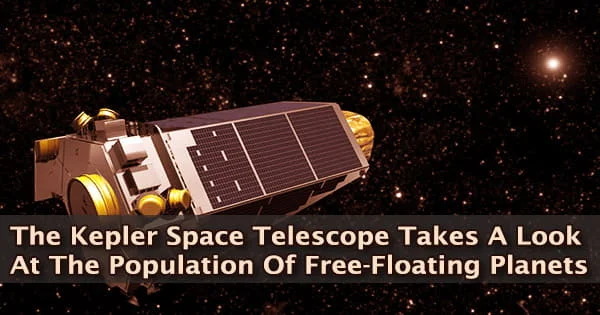A mystery population of “free-floating” planets has been discovered, planets that may be alone in deep space, unfettered by any home star. The findings, which were published today in Monthly Notices of the Royal Astronomical Society, include four new finds that are consistent with planets of similar masses to Earth.
The study, conducted by Iain McDonald of the University of Manchester in the United Kingdom (now at the Open University in UK), used data collected in 2016 during NASA’s Kepler Space Telescope’s K2 mission phase.
During this two-month mission, Kepler observed a dense field of millions of stars around the galactic center every 30 minutes in the hopes of detecting rare gravitational microlensing occurrences.
The researchers discovered 27 possible microlensing signals with short durations ranging from an hour to ten days. Many of these have previously been noticed in data collected from the ground at the same time.
The Kepler space telescope was launched by NASA in 2009 with the goal of discovering Earth-size planets orbiting other stars. The spacecraft was launched into an Earth-trailing heliocentric orbit and was named after astronomer Johannes Kepler.
Kepler’s only scientific instrument was a photometer that measured the brightness of about 150,000 main sequence stars in a fixed field of view. The four shortest events, on the other hand, are new finds that are consistent with planets with masses similar to Earth’s.
These signals are extremely difficult to find. Our observations pointed an elderly, ailing telescope with blurred vision at one of the most densely crowded parts of the sky, where there are already thousands of bright stars that vary in brightness and thousands of asteroids that skim across our field.
Iain McDonald
These new events do not have a longer signal than would be expected from a host star, indicating that they could be free-floating planets. Such planets could have formed around a host star before being ejected by the gravitational pull of the system’s other, heavier planets.
Microlensing illustrates how the light from a background star can be briefly enlarged by the presence of additional stars in the foreground, as predicted by Albert Einstein 85 years ago as a result of his General Theory of Relativity. This results in a brief burst of brilliance that can last anywhere from a few hours to a few days.
Microlensing affects roughly one out of every million stars in our Galaxy at any given time, although only a small percentage of them are thought to be caused by planets.
Kepler was not built to detect planets through microlensing or to examine the inner Galaxy’s incredibly dense star fields. To seek for signals inside the Kepler dataset, new data reduction techniques had to be created.
Iain notes: “These signals are extremely difficult to find. Our observations pointed an elderly, ailing telescope with blurred vision at one the most densely crowded parts of the sky, where there are already thousands of bright stars that vary in brightness, and thousands of asteroids that skim across our field.”
“From that cacophony, we try to extract tiny, characteristic brightenings caused by planets, and we only have one chance to see a signal before it’s gone. It’s about as easy as looking for the single blink of a firefly in the middle of a motorway, using only a handheld phone.”
Co-author Eamonn Kerins of the University of Manchester also comments, “Kepler has achieved what it was never designed to do, in providing further tentative evidence for the existence of a population of Earth-mass, free-floating planets. Now it passes the baton on to other missions that will be designed to find such signals, signals so elusive that Einstein himself thought that they were unlikely ever to be observed. I am very excited that the upcoming ESA Euclid mission could also join this effort as an additional science activity to its main mission.”
The NASA Nancy Grace Roman Space Telescope and perhaps the ESA Euclid mission, both of which will be optimized to look for microlensing signals, will be focused on confirming the existence and nature of free-floating planets.





